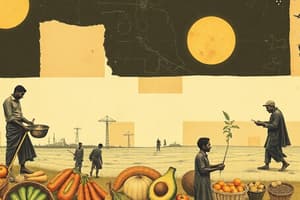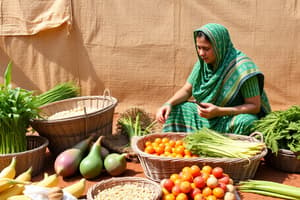Podcast
Questions and Answers
What has contributed to the increase in the maintenance cost of procuring foodgrains in India?
What has contributed to the increase in the maintenance cost of procuring foodgrains in India?
The rising Minimum Support Prices (MSP), along with increased transportation and storage costs of the Food Corporation of India (FCI), have contributed to the increased maintenance costs.
How has per capita consumption of rice changed in rural India from 2004-05 to 2011-12?
How has per capita consumption of rice changed in rural India from 2004-05 to 2011-12?
Per capita consumption of rice in rural India decreased from 6.38 Kg in 2004-05 to 5.98 Kg in 2011-12.
What role do cooperatives play in food security in India?
What role do cooperatives play in food security in India?
Cooperatives contribute to food security by setting up shops that sell low-priced goods, particularly in southern and western India.
What challenges are faced by PDS dealers in India regarding the distribution of foodgrains?
What challenges are faced by PDS dealers in India regarding the distribution of foodgrains?
How has the per capita consumption of PDS wheat changed in India since 2004-05?
How has the per capita consumption of PDS wheat changed in India since 2004-05?
What was India's foodgrain production in 2015–16, and how did it change by 2016–17?
What was India's foodgrain production in 2015–16, and how did it change by 2016–17?
Which two states recorded significant wheat production in 2015–16 and what were their respective outputs?
Which two states recorded significant wheat production in 2015–16 and what were their respective outputs?
Identify the two states that had substantial rice production in 2015–16 and their production figures.
Identify the two states that had substantial rice production in 2015–16 and their production figures.
What was the impact of the Green Revolution on India's food security since its inception?
What was the impact of the Green Revolution on India's food security since its inception?
What measures did Indian policymakers adopt after Independence regarding food production?
What measures did Indian policymakers adopt after Independence regarding food production?
What special recognition did Indira Gandhi give to the achievements in wheat production?
What special recognition did Indira Gandhi give to the achievements in wheat production?
How has the percentage of seasonal and chronic hunger changed in India, as indicated in the content?
How has the percentage of seasonal and chronic hunger changed in India, as indicated in the content?
What is the purpose of creating buffer stock in India?
What is the purpose of creating buffer stock in India?
How does the public distribution system (PDS) function in India?
How does the public distribution system (PDS) function in India?
What role does the Food Corporation of India (FCI) play in India’s food security?
What role does the Food Corporation of India (FCI) play in India’s food security?
What food grains are primarily involved in India’s buffer stock system?
What food grains are primarily involved in India’s buffer stock system?
What is the significance of ration shops in the public distribution system?
What is the significance of ration shops in the public distribution system?
What challenges do ration shops face in their operation?
What challenges do ration shops face in their operation?
How does buffer stock help during periods of calamity in India?
How does buffer stock help during periods of calamity in India?
What is the relationship between buffer stock and food security in India?
What is the relationship between buffer stock and food security in India?
Why is it important for buffer stock to be procured from states with surplus production?
Why is it important for buffer stock to be procured from states with surplus production?
What is the main purpose of ration shops in India?
What is the main purpose of ration shops in India?
What initiated the introduction of rationing in India?
What initiated the introduction of rationing in India?
How many types of ration cards are mentioned, and what is their significance?
How many types of ration cards are mentioned, and what is their significance?
What items can families collect from the ration shop monthly?
What items can families collect from the ration shop monthly?
During which decade was the rationing system revived in India due to food shortages?
During which decade was the rationing system revived in India due to food shortages?
What are some of the key food intervention programs introduced in the mid-1970s?
What are some of the key food intervention programs introduced in the mid-1970s?
What is the significance of the Public Distribution System (PDS)?
What is the significance of the Public Distribution System (PDS)?
How have food intervention programs evolved over the years in India?
How have food intervention programs evolved over the years in India?
What role does the National Sample Survey Office (NSSO) play concerning poverty levels?
What role does the National Sample Survey Office (NSSO) play concerning poverty levels?
How can one determine the prices of rice and sugar at the ration shop compared to other grocery stores?
How can one determine the prices of rice and sugar at the ration shop compared to other grocery stores?
In which recent year did the foodgrain stock with the government reach its maximum level and what was that amount?
In which recent year did the foodgrain stock with the government reach its maximum level and what was that amount?
What is the minimum buffer stock norm for the Food Corporation of India (FCI)?
What is the minimum buffer stock norm for the Food Corporation of India (FCI)?
Why were the FCI granaries overflowing with foodgrains during the peak periods?
Why were the FCI granaries overflowing with foodgrains during the peak periods?
What has primarily caused the shift in land use from coarse grains to rice and wheat production?
What has primarily caused the shift in land use from coarse grains to rice and wheat production?
Which regions in India are noted for high concentrations of wheat and rice production?
Which regions in India are noted for high concentrations of wheat and rice production?
What is one environmental impact of the intensive cultivation of rice mentioned in the content?
What is one environmental impact of the intensive cultivation of rice mentioned in the content?
What are the downsides of maintaining a high level of buffer stocks as mentioned in the passage?
What are the downsides of maintaining a high level of buffer stocks as mentioned in the passage?
How have government schemes influenced foodgrain distribution?
How have government schemes influenced foodgrain distribution?
What has been a consequence of diverting land from coarse grains to rice and wheat?
What has been a consequence of diverting land from coarse grains to rice and wheat?
What is a key challenge faced by farmers due to high MSP and its effect on crop diversity?
What is a key challenge faced by farmers due to high MSP and its effect on crop diversity?
Flashcards
Green Revolution
Green Revolution
The significant increase in agricultural production, especially in wheat and rice, that occurred in India starting in the 1970s.
Self-sufficiency in food grains
Self-sufficiency in food grains
The goal of a nation to produce enough food to feed its entire population without relying on imports.
Food Security in India
Food Security in India
A strategy developed by the Indian government after independence aimed at achieving self-sufficiency in food grains.
Foodgrain Production
Foodgrain Production
Signup and view all the flashcards
Impact of 'Green Revolution' on India.
Impact of 'Green Revolution' on India.
Signup and view all the flashcards
Food Security
Food Security
Signup and view all the flashcards
Decline in Hunger
Decline in Hunger
Signup and view all the flashcards
Ration shop
Ration shop
Signup and view all the flashcards
Ration card
Ration card
Signup and view all the flashcards
Antyodaya card
Antyodaya card
Signup and view all the flashcards
BPL card
BPL card
Signup and view all the flashcards
APL card
APL card
Signup and view all the flashcards
Public Distribution System (PDS)
Public Distribution System (PDS)
Signup and view all the flashcards
Mid-day meals
Mid-day meals
Signup and view all the flashcards
Food-for-Work (FFW)
Food-for-Work (FFW)
Signup and view all the flashcards
Poverty Alleviation Programmes (PAPs)
Poverty Alleviation Programmes (PAPs)
Signup and view all the flashcards
Bengal famine
Bengal famine
Signup and view all the flashcards
What is a Buffer Stock?
What is a Buffer Stock?
Signup and view all the flashcards
What is the Public Distribution System (PDS)?
What is the Public Distribution System (PDS)?
Signup and view all the flashcards
How does the FCI procure foodgrains for the buffer stock?
How does the FCI procure foodgrains for the buffer stock?
Signup and view all the flashcards
How are farmers compensated for their foodgrains?
How are farmers compensated for their foodgrains?
Signup and view all the flashcards
How are foodgrains from the buffer stock distributed?
How are foodgrains from the buffer stock distributed?
Signup and view all the flashcards
What is the purpose of the Public Distribution System?
What is the purpose of the Public Distribution System?
Signup and view all the flashcards
What additional benefit does the PDS provide?
What additional benefit does the PDS provide?
Signup and view all the flashcards
How does the PDS contribute to food security in India?
How does the PDS contribute to food security in India?
Signup and view all the flashcards
Where are ration shops located?
Where are ration shops located?
Signup and view all the flashcards
Minimum Support Price (MSP)
Minimum Support Price (MSP)
Signup and view all the flashcards
Rising MSP and Government Burden
Rising MSP and Government Burden
Signup and view all the flashcards
Rice Consumption Trend
Rice Consumption Trend
Signup and view all the flashcards
Role of Cooperatives in Food Security
Role of Cooperatives in Food Security
Signup and view all the flashcards
What is a subsidy?
What is a subsidy?
Signup and view all the flashcards
What is the Minimum Buffer Norm?
What is the Minimum Buffer Norm?
Signup and view all the flashcards
What is the role of the FCI?
What is the role of the FCI?
Signup and view all the flashcards
Why were FCI granaries overflowing in 2014?
Why were FCI granaries overflowing in 2014?
Signup and view all the flashcards
What caused the large food grain stock in 2014?
What caused the large food grain stock in 2014?
Signup and view all the flashcards
How did MSP affect crop choices?
How did MSP affect crop choices?
Signup and view all the flashcards
What is the environmental impact of increased rice production?
What is the environmental impact of increased rice production?
Signup and view all the flashcards
What are the downsides of large food stock?
What are the downsides of large food stock?
Signup and view all the flashcards
How did the government deal with the excess foodgrains?
How did the government deal with the excess foodgrains?
Signup and view all the flashcards
Is a high level of buffer stock desirable?
Is a high level of buffer stock desirable?
Signup and view all the flashcards
Study Notes
Food Security in India
- Food security is defined as the availability, accessibility, and affordability of food for all people at all times.
- Vulnerable populations, like poor households, are especially susceptible to food insecurity during times of crop failures or disruptions in the food supply chain.
- Food security encompasses more than just having enough calories to eat; it involves:
- Availability: Sufficient food production within the nation, plus imports and existing stored reserves.
- Accessibility: Food being readily available to all individuals within a society.
- Affordability: Financial capacity of people to purchase sufficient, safe, and nutritious foods.
- Food security is influenced by natural disasters, impacting production and accessibility.
- Natural calamities like drought, floods, earthquakes, etc., can drastically decrease food production, leading to shortages and price hikes, making food less affordable for some.
- The Bengal Famine of 1943, which resulted in the deaths of millions, highlights the fragility of food security in the face of widespread shortages.
- Vulnerable groups, such as agricultural laborers, transport workers, and the poor, are most affected by food crises.
Dimensions of Food Security
- Availability: Sufficient quantities of food are produced and/or imported.
- Accessibility: Food is within reach of everyone. This considers transport, storage and distribution systems.
- Affordability: Individuals can obtain the food they need with their resources, and it's economical for them.
Why Food Security Matters
- Ensures basic necessities for all individuals in society.
- Prevents widespread hunger and starvation, especially among vulnerable groups.
- Essential for long-term development and economic growth.
- Crucial for maintaining social stability and preventing mass migration.
Government's Role in Food Security
- Public Distribution System (PDS) is a vital government program delivering essential food items at affordable prices.
- Implementing measures to address food emergencies and shortages.
- Adopting strategies to increase food production.
- Measures taken through different programs to ensure food security of the poor.
The Green Revolution in India
- India achieved self-sufficiency in grains following the Green Revolution.
- Introduction of improved crop varieties, irrigation techniques, and fertilizer use contributed to boosted food production.
Buffer Stock
- Government maintains stocks of essential foodstuffs for distribution in food-deficient regions.
- This is done to stabilize prices during times of shortages or to address emergencies.
Minimum Support Price
- The minimum price the government guarantees to farmers for their produce.
- This serves as an incentive for higher agricultural output and a crucial tool to maintain price stability.
Food Insecurity
- Chronic hunger, stemming from consistent inadequate food intake, is a significant aspect of food insecurity.
- Seasonal food insecurity occurs due to fluctuations in food availability linked to agricultural cycles.
Studying That Suits You
Use AI to generate personalized quizzes and flashcards to suit your learning preferences.




